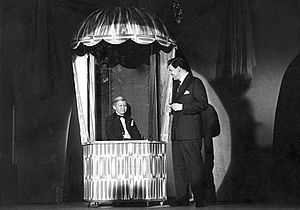Ulf Hannerz
| Part of a series on |
| Political and legal anthropology |
|---|
|
Basic concepts
|
|
Case studies
|
|
Related articles |
|
Major theorists
|
| Social and cultural anthropology |
Ulf Hannerz, (born 9 June 1942 in Malmö), is an emeritus professor of social anthropology at Stockholm University.[2] His research includes urban societies, local media cultures, transnational cultural processes, and globalization.
His works Soulside and Exploring the City are classic books in the area of urban anthropology.[3]
Hannerz is the author of “Cosmopolitans and Locals in World Culture” (1990). His theory essentially explores cosmopolitanism from the analysis of expatriates.
In 2000, Hannerz delivered the Lewis Henry Morgan Lecture at the University of Rochester,[4] considered by many to be the most important annual lecture series in the field of Anthropology.[5]
Hannerz is a member of the Royal Swedish Academy of Sciences.[4][6] In 2005, he received an honorary doctorate from The Faculty of Social Sciences, University of Oslo.[3]
The 10,000 Kronor Question

Hannerz gained some notability as a child, when he appeared on the first episode of the television game show Kvitt eller dubbelt - 10.000 kronorsfrågan (literally: Double or Nothing - The 10,000 Kronor Question), which was based on the American television show The $64,000 Question.[7] In the first episode, aired on 12 January 1957, 14-year-old Hannerz presented by his nickname Hajen (The Shark), was quizzed on the subject "tropical aquarium fish". Hannerz succeeded in winning 10,000 Kronor due to a judgement error in the program. The judge asked him which of the seven displayed fish had lids. He answered "hundfisk¨" (mudminnow). No, the judge said, it's "slamkrypare" (mudskipper); he wanted to dismiss young Ulf from the game show. However, Ulf Hannerz was indeed correct and the name slamkrypare (mudskipper) entered the Swedish language as a term for a cocksure, but incorrect, assertion.[1][8]
Books
- (1969, 2004) Soulside: Inquiries into Ghetto Culture and Community 2004: ISBN 0-226-31576-2
- (1974) Caymanian Politics: Structure and Style in a Changing Island Society
- (1980) Exploring the City: Inquiries Toward an Urban Anthropology, ISBN 0-231-08376-9
- (2006) Spanish translation: La Exploracion de La Ciudad, ISBN 84-375-0369-8
- (1992) Cultural Complexity: Studies in the Social Organization of Meaning
- (1996) Transnational Connections: Culture, People, Places
- (1998) Spanish translation: Conexiones Transnacionales - Cultura Gente Lugares, ISBN 84-376-1629-8
- (2006) Polish translation: Powiązania transnarodowe: kultura, ludzie, miejsca, ISBN 83-233-2183-3
- (2000, with Kjell Goldmann, Ulf Hannerz, Charles Westin, eds.) Nationalism and Internationalism in the Post-Cold War Era
- (2000) Flows, Boundaries and Hybrids: Keywords in Transnational Anthropology
(1992) Culture, Cities and the World (1986, with Ulla Wagner) Anthropology of Immigration in Sweden
- (2004) Foreign News: Exploring the World of Foreign Correspondents
- (2010) Anthropology's World: Life in a Twenty-First Century Discipline ISBN 978-0-7453-3047-1
Further reading
References
- ↑ 1.0 1.1 SVT 50 år : Klippsk kille, Swedish Television (Swedish language), accessed September 15, 2011
- ↑ Ulf Hannerz, Professor Emeritus, Department of Social Anthropology, Stockholm University. Website accessed September 15, 2011.
- ↑ 3.0 3.1 Hannerz profile at the University of Oslo
- ↑ 4.0 4.1 Key Figures in Creole Studies - Ulf Hannerz, Warwick University Department of Sociology website, accessed September 15, 2011
- ↑ 051 Matory To Join Duke Faculty, The Harvard Crimson, September 16, 2008
- ↑ "The Royal Swedish Academy of Sciences: Ulf Hannerz". Retrieved 2009-05-01.
- ↑ Schulman Allan, Såg du?: TV vi minns under tjugofem år : en bildkrönika. Höganäs: Bra böcker, 1980
- ↑ Södra Ängby - trädgårdsstad i funkis, Gunnar Olofgörs et al, Stockholm : Stockholmia, 2001
|